When it comes to leading-edge Mexican cooking, Dallas has long been a trail-blazing city.
La Valentina de Mexico restaurant pioneered the way when it opened in Far North Dallas in 1996, featuring traditional ingredients like blue-corn masa, huitlacoche (corn fungus) and flores de calabaza (squash blossoms) in modern iterations. Monica Greene and Joanne Bondy made a huge splash with their modern Mexican restaurant Ciudad four years later. And in 2011, led by Anastacia Quiñones-Pittman at a since-shuttered restaurant called Alma, Dallas chefs were among the first in the United States to feature hand-made tortillas and other dishes fashioned from masa made in-house by nixtamalizing corn. (Nixtamalizing is the process by which dried corn kernels are cooked in and soaked in a calcium hydroxide, or culinary lime, solution to make them suitable for grinding into masa dough, used to make tortillas.)
Now Olivia Lopez — a 31-year-old chef who until recently was chef de cuisine at Billy Can Can — is one of a small but growing group of chefs in the United States exploring the next wave of Mexican cooking: Nixtamalizing heirloom corn grown in Mexico, grinding it into masa and featuring it in all kinds of dishes.
Lopez’s plan is to open a tortilla and masa shop in Dallas, inspired by Molino El Pujol, star chef Enrique Olvera’s shop in Mexico City.
The seeds of the project began germinating about two years ago, when Lopez took time off to spend time in Mexico, her native country. She’s from Colima, on the west coast south of Puerto Vallarta.
“The most important part of the Mexican diet is corn,” Lopez says. Yet nearly all of the corn products we eat in the U.S. and Mexico are made from industrially farmed corn. During her extended visit, she sought out sources of heirloom corn, and visited the head of an heirloom corn cooperative in Jalisco (the state adjacent to Colima to the north). She was amazed by what she learned and tasted.
“I saw about 200 varieties of corn that day,” she says. “This one comes from this community; this other one comes from that community. And that’s what I found very important.”
Each variety, she learned, is suited to different uses, and each has unique flavor and texture. “Big companies were trying to buy corn from him. He refused because they’d have to change the growing process. They respect the land and the seasons.” Many are organically grown, she says. They are bio-diverse; none are genetically modified.
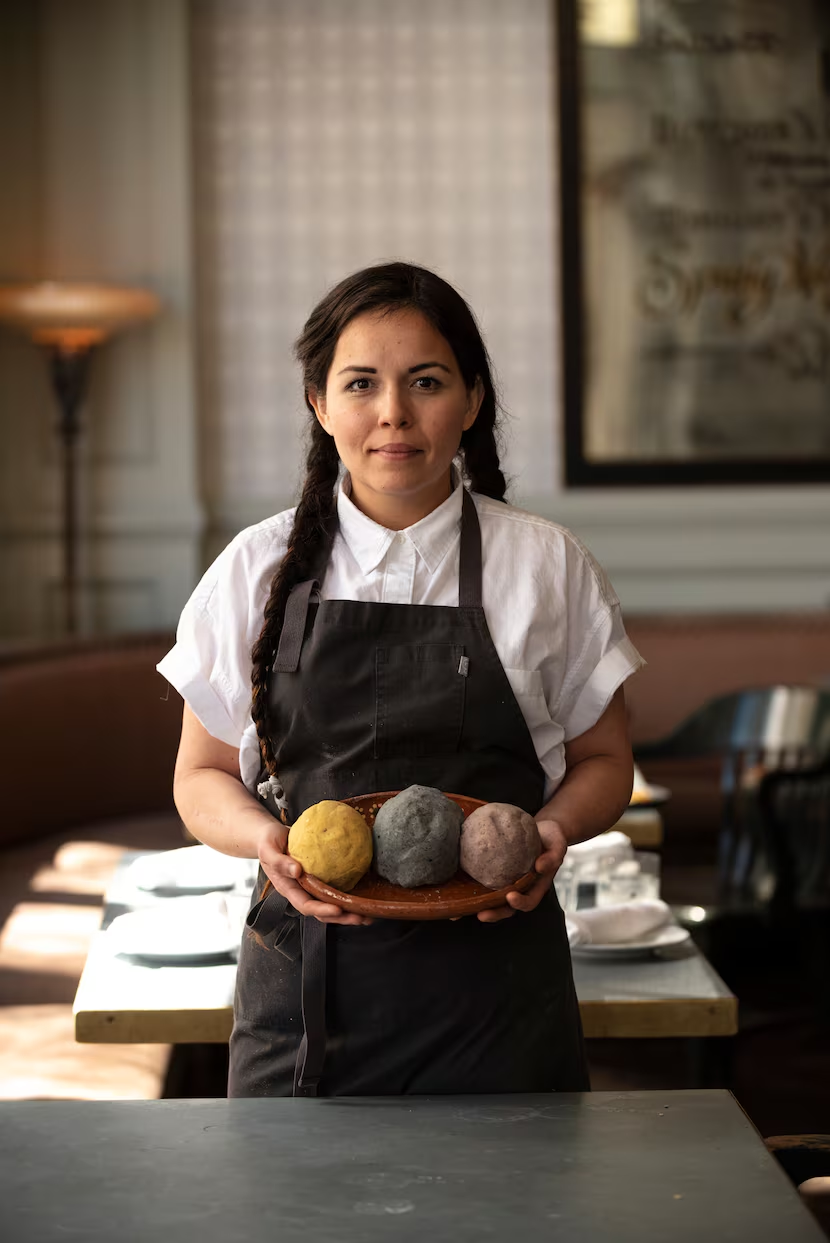
The community aspect of heirloom corn is extremely important to Lopez. All over Mexico, she says, “All the communities were close to disappearing” because no one was consuming these heirlooms grown by small-scale farmers. “Maseca, which is by far the biggest masa harina brand in Mexico, is a lot cheaper.”
When Lopez came back to the U.S., she had mission: “to start working in corn.” Her short-term goal was to create heirloom corn-centric dishes at Billy Can Can — such a scallop ceviche tostada with a base made from blue heirloom bolita corn from Oaxaca.
To start her work in corn and masa, she needed a mill. It didn’t make sense for the owners of Billy Can Can to buy one; molinos are extremely large (impossible for a restaurant kitchen that wasn’t designed for it), and cost between $7,000 and $10,000. Through a Los Angeles-based company called Masienda, Lopez found a molinito — a much smaller mill that weighs 82 pounds, with a footprint of a couple square feet and a price tag of $1,750. She bought it for herself, used it to make masa for Billy Can Can, and now makes masa at home, as research and development for her tortilla shop.
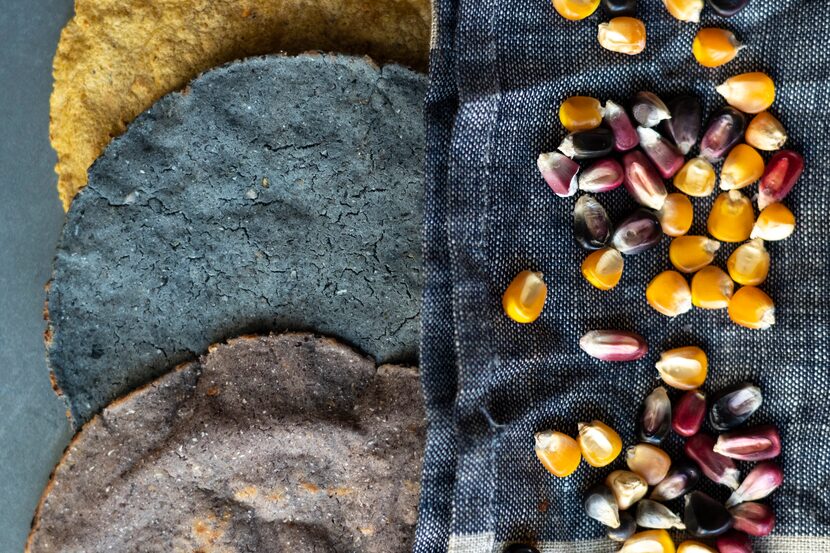
As it turns out, Masienda sells a dozen varieties of heirloom corn sourced from all around Mexico — the blue chalqueño azul Lopez loves for the scallop ceviche tostadas, white olotillo blanco she likes to use for sweet pineapple tamales, pink xocoyul rosado from Tlaxcala that’s her current favorite. “It’s the sweetest one,” she says; “it’s very fragrant.” (Masienda also supplies heirloom corn to Olvera at his New York City restaurant Cosme, along with top U.S. chefs working in the Mexican idiom.)
All of which will be dandy, once we can start shopping and eating in Lopez’s shop. But where does that leave home cooks who want to explore these heirloom corns and the treats to be made using them?
Lopez stumbled into the answer during early pandemic, when shipment of her molinito was delayed for months, and she was scheduled to cook a private dinner featuring the masas. Masienda offered to send her single-source masa harina it makes from several heirloom varieties. (Masa harina is flour made from dried masa — just add water and it becomes masa.)
She was blown away by its quality — and so will you be if you’re accustomed to cooking with Maseco or other industrial masa harina, and you order some from Masienda. Stir in water, knead it briefly till it’s tacky but not too sticky, and not dry or crumbly. Make tostadas from the Oaxacan blue bolita to make the bases for scallop ceviche (yes, Lopez shared her recipe!). Make tortillas to serve with Lopez’ recipe for chicken with pipián roja, a rich, mole-like dish that’s popular in Lopez’s home town, Colima. Or use white olotillo masa harina to make sweet pineapple tamales, also a dish born in Colima.
Of course that’s just the beginning. If you’re anything like Lopez (or me!), you’ll find the masa harina upgrade to be life-changing.
Former Dallas Morning News restaurant critic Leslie Brenner, now a restaurant consultant and writing teacher, writes about cooking at Cooks Without Borders.
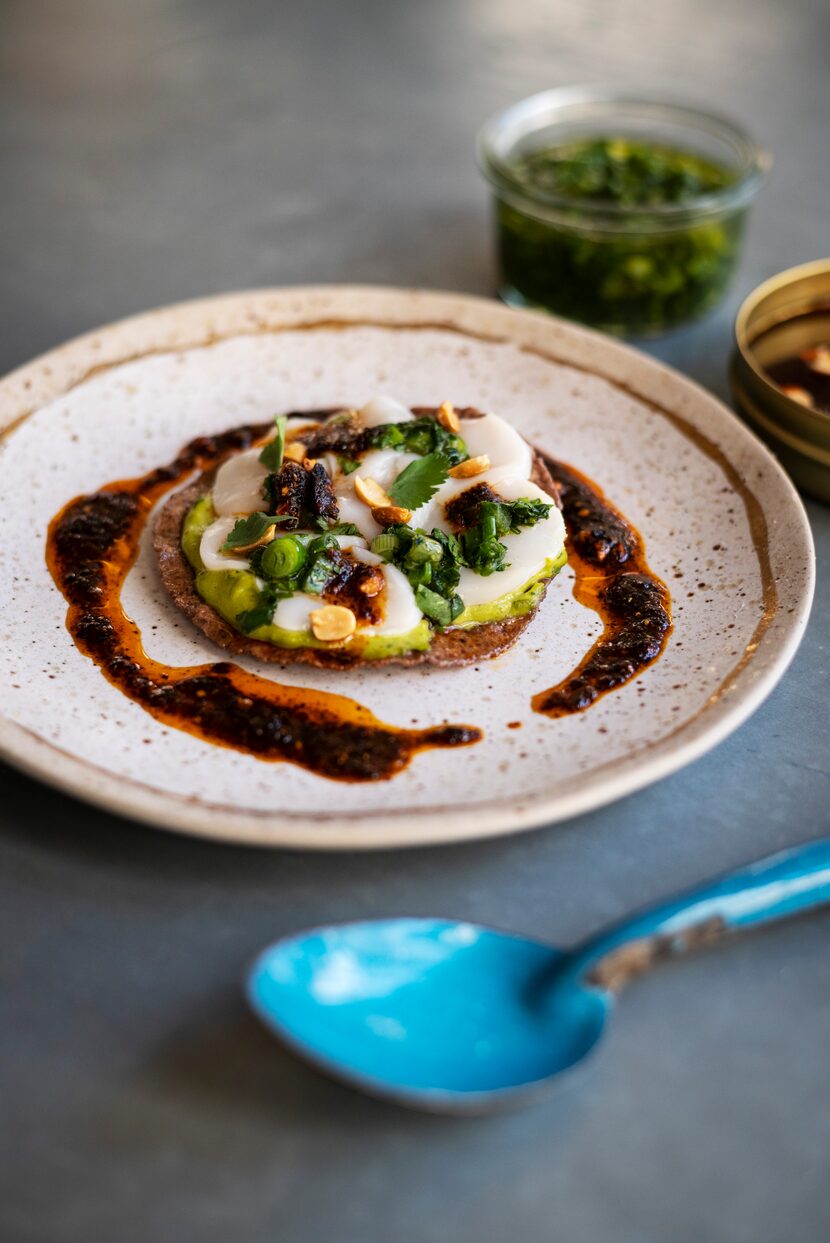
Ceviche Tostadas
These tostadas are a nice way to feature heirloom masa. If you’d like to make your own tostada bases, follow the instructions. We highly recommend masa harina purchased online from Masienda, but any masa harina or Maseca can be used. Otherwise, use purchased tostadas, or purchase corn tortillas and follow the instructions below for baking them till crisp.
Our recipe calls for 8-12 scallops, or about 10 to 12 ounces. In case you want to make more tostadas, the amounts shown here should be enough for about 1 1/4 pounds of scallops.
Juice of 4 limes
Juice of 1 orange
1 ½ teaspoons salt
8 to 12 scallops (about 10 to 12 ounces), sliced crosswise into ⅜-inch rounds
4 tostadas (see headnote, and see below)
Avocado Purée (recipe follows)
8 teaspoons Scallion Condiment, or to taste (recipe follows)
¼ cup Salsa Macha, or to taste (recipe follows)
Toasted peanuts for garnish
Cilantro for garnish (optional)
Place the lime juice and orange juice in a non-reactive bowl, add the salt and whisk to dissolve. Add the scallops, and let marinate for 5 or 6 minutes.
While the scallops are marinating, spread 1/4 of the Avocado Purée on each of four tostadas. Use a slotted spoon to transfer 1/4 of the marinated scallops on top of the avocado purée. Repeat for the other three tostadas.
Place each tostada on an individual serving plate and garnish each with dots of the Scallion Condiment on top of the scallops, about 2 teaspoons for each tostada (or more or less, according to taste). Garnish each plate with about a tablespoon Salsa Macha — some drizzled around the plate and some on top of the tostada. Finish each tostada with a few toasted peanuts and cilantro (if desired) and serve immediately.
Makes 4 servings.
Source: Olivia Lopez
Avocado Purée: Purée 2 avocados, 1 tablespoon extra-virgin olive oil, ½ bunch cilantro, ½ teaspoon salt and 2 tablespoons water.
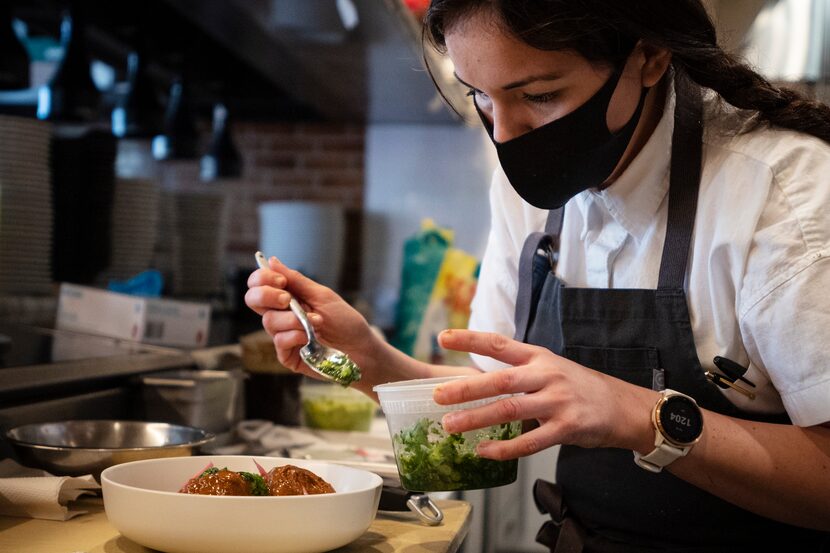
Tostadas (bases)
½ cup masa harina
½ cup plus 1 tablespoon water
Heat a comal or a well seasoned cast iron skillet or griddle over medium-high heat. Heat the oven to 200 F. Set a rack atop a baking sheet and set aside.
Put the masa harina in a bowl, stir in the water, then use your hands to knead it until the water is evenly absorbed. The goal is a dough that is slightly tacky but not sticky. Make a ball with 28 or 29 grams (about 1 ounce) of dough (if you don’t have a scale, divide the dough into sixths). Line a tortilla press with plastic on both sides, and press the ball into a tortilla about 5 ½ inches wide.
Peel the top plastic off the tortilla, invert it carefully onto your open palm, and then transfer it to the heated comal. Let it cook 15 to 30 seconds, until the edges lift up from the comal a bit. Use a spatula to flip it over, and cook another 30 seconds. Flip it once more and cook another 30 to 45 seconds. If it puffs up, gently press it flat with the spatula, as you want the tostadas to be flat. Transfer the tortilla to the rack on the baking sheet. Repeat with the remaining dough.
Bake the tortillas 60 minutes, until they are fully crisp throughout.
Makes 6 tostadas.
Scallion Condiment
1 serrano chile, seeds removed and cut into small dice
¼ bunch cilantro, chopped
1 bunch scallions, thinly sliced (white and green parts)
2 tablespoons extra-virgin olive oil
1 tablespoon lime juice
½ teaspoon salt
In a medium bowl, combine the serrano chile, cilantro, scallions, olive oil, lime juice and salt. Taste and adjust seasoning, adding salt and/or lime juice as necessary.
Makes about 1 cup.
Salsa Macha
1 large ancho chile
1 large guajillo chile
3 chile de arbol
1 cup extra-virgin olive oil
2 garlic cloves, chopped
⅛ cup raw peanuts
2 ½ teaspoons sesame seeds
1 teaspoon apple cider vinegar
½ teaspoon dried Mexican oregano
½ teaspoon salt (or to taste)
Remove the stems and seeds from the ancho, guajillo and chiles de arbol. Chop them or use scissors to cut them into small pieces — about ¼-inch each, though you don’t need to be precise as they’ll be pulsed in a blender later.
Place the olive oil in a small saucepan with the garlic, peanuts and sesame seeds and heat them over medium-high for 5 minutes, or until the garlic starts to crisp and the seeds turn golden brown. Remove from heat and stir in the ancho, guajillo and arbol chiles. Let cool for 10 minutes.
Put mixture in a blender along with the cider vinegar, oregano and salt, and pulse several times until the salsa is nicely combined. Do not over-blend, as you want it to have nice crispy bits rather than be a smooth purée. Taste and adjust salt, if necessary. Keeps well refrigerated in a jar with a close-fitting lid for up to one month.
Makes about 1 ¼ cups.
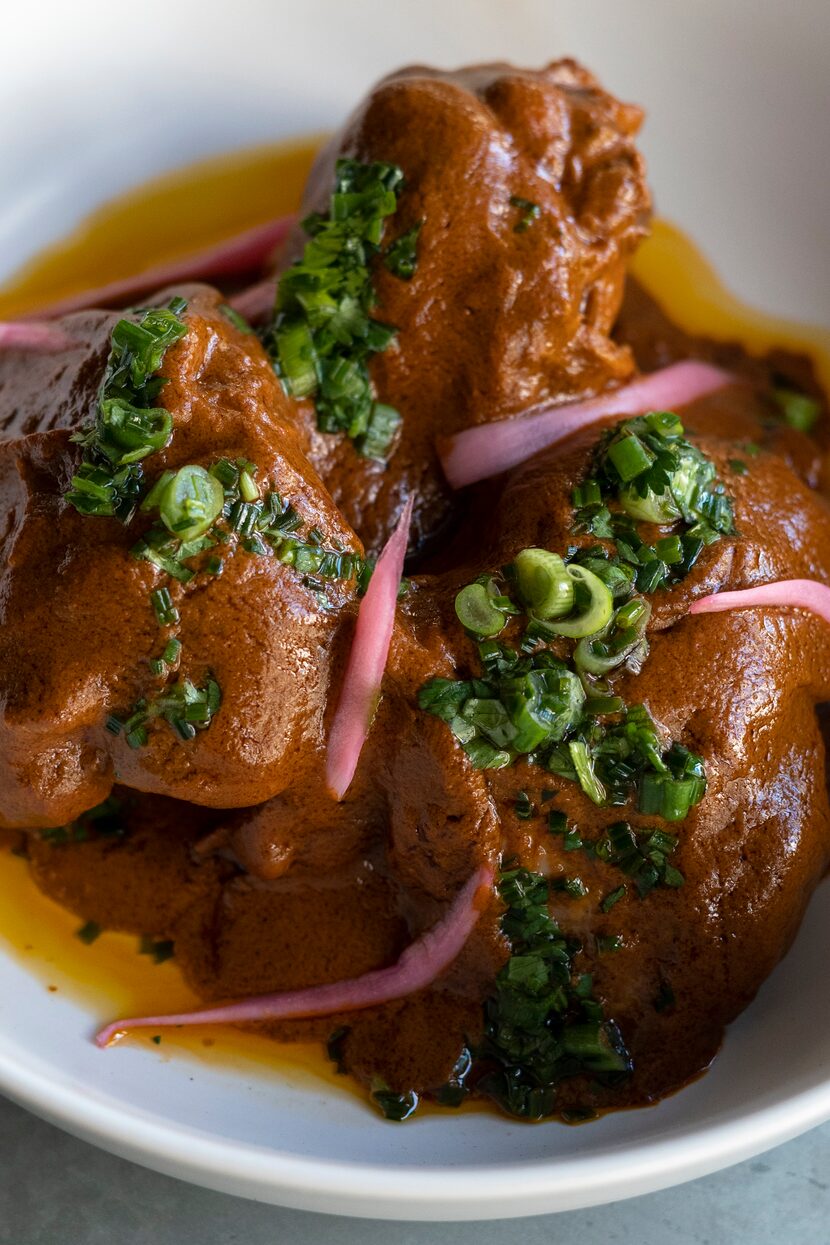
Pollo en Pipián Rojo
For the sauce:
3 medium ancho chiles
3 medium guajillo chiles
6 juniper berries
1 1/2 teaspoons black peppercorns
1 1/2 teaspoons cumin seeds
3 whole cloves
1 tablespoon coriander seeds
6 whole allspice
1 cup raw pepitas (pumpkin seeds)
1/2 cup raw peanuts
1/4 cup white sesame seeds
2 medium tomatoes, cut in half horizontally
1 medium yellow onion, roughly chopped
2 large garlic cloves
1/2 teaspoon ground cinnamon
1 chipotle in adobo
2 tablespoons apple cider vinegar
1 1/2 teaspoons brown sugar (light or dark)
1 1/2 teaspoons salt
For the chicken:
8 -10 bone-in chicken thighs, about 3 pounds
Salt
Freshly ground black pepper
2 tablespoons olive oil
1/2 cup chicken broth or water
Pickled Onions (recipe below)
Scallion Condiment (optional, see sub-recipe for Scallop Ceviche Tostadas)
Hand-made corn tortillas, preferably made with heirloom masa harina (see recipe below) or store-bought corn tortillas
Red rice and beans, if desired
Heat oven to 350 F. Place the ancho and guajillo chiles on a baking sheet lined with parchment, along with the juniper berries, black peppercorns, cumin seeds, cloves, coriander seeds and allspice, and toast them in the oven for 4 minutes.
Remove the stems and seeds from the ancho and guajillo chiles, place them in a bowl, cover with hot water and rehydrate for 15 minutes or so.
While the chiles rehydrate, transfer juniper berries, peppercorns, cumin, cloves and coriander to a spice grinder (keeping the parchment on the baking sheet, which you’ll use again) and grind them to a powder. Place the ground spices in the jar of a blender and set aside.
Place the pepitas, peanuts and sesame seeds on the same parchment-lined baking sheet and toast them for 6 minutes. Remove them from the oven, transfer the seeds to the blender jar and set aside (keeping the parchment on the baking sheet).
Heat the broiler. Place the tomatoes, cut-side up, on the baking sheet and place them under the broiler until lightly charred, about 3 to 5 minutes. Place them in the blender jar.
Drain the ancho and guajillo chiles and add them to the blender jar, along with the chipotle, 1/2 cup water, the apple cider vinegar, brown sugar and salt. Blend until smooth, adding more water if necessary to get a nice, smooth sauce. Transfer the sauce to a saucepan, taste and adjust seasoning, and keep warm.
Season the chicken thighs with salt and pepper. In a large skillet or wide Dutch oven, heat the olive oil over medium-high heat. Add the chicken thighs and sear them on both sides, about 5 minutes per side. Remove the chicken to a plate or bowl, add the chicken broth or water to the pan (still over medium-high heat), and deglaze the pan, using a wooden spoon to scrape up any browned bits.
Return the chicken thighs to the pan and pour the pipián sauce over them. If the sauce has become too thick (it should be like a thick gravy), add water as necessary. Bring the sauce to a simmer over high heat, reduce the heat to medium and simmer, partially covered, until the chicken is cooked through (it should register 165 F on an instant-read thermometer), about 25 minutes. Garnish with the pickled onions, along with dabs of scallion condiment, if desired. Serve with tortillas, and (if desired) red rice and beans.
Makes 4 to 6 servings.
Source: Olivia Lopez.
Pickled Onions
1/2 cup apple cider vinegar
1/2 cup white wine vinegar
Scant 1/2 teaspoon salt
6 black peppercorns
1 sliced garlic clove
2 teaspoons dried Mexican oregano
1/2 red onion, thinly sliced
Put the apple cider vinegar and white wine vinegar in a small saucepan with the salt, peppercorns, garlic and oregano, and bring to a simmer over medium heat. Add the red onion, and simmer, stirring, for one minute. Transfer to a glass bowl or jar and let cool.
Source: Leslie Brenner
Corn Tortillas
1 cup masa harina, preferably made from heirloom corn
1 cup plus 2 tablespoons water
Heat a comal or a well seasoned cast-iron skillet or griddle over medium-high heat.
Put the masa harina in a bowl, and stir in the water, then use your hands to knead it until the water is evenly absorbed. The goal is a dough that is slightly tacky but not sticky. Make a ball with 28 or 29 grams (about 1 ounce) of dough. Line a tortilla press with plastic on both sides, and press the ball into a tortilla about 5 ½ inches wide.
Peel the top plastic off the tortilla, invert it carefully onto your open palm, and then transfer it to the heated comal. Let it cook 15 to 30 seconds, until the edges lift up from the comal a bit. Use a spatula to flip it over, and cook another 30 seconds. Flip it once more and cook another 30 to 45 seconds. It should puff up, but don’t worry if it does not. As you finish each tortilla, place it between towels or in an insulated tortilla pouch. Together they will steam a bit and stay pliable.
Source: Leslie Brenner
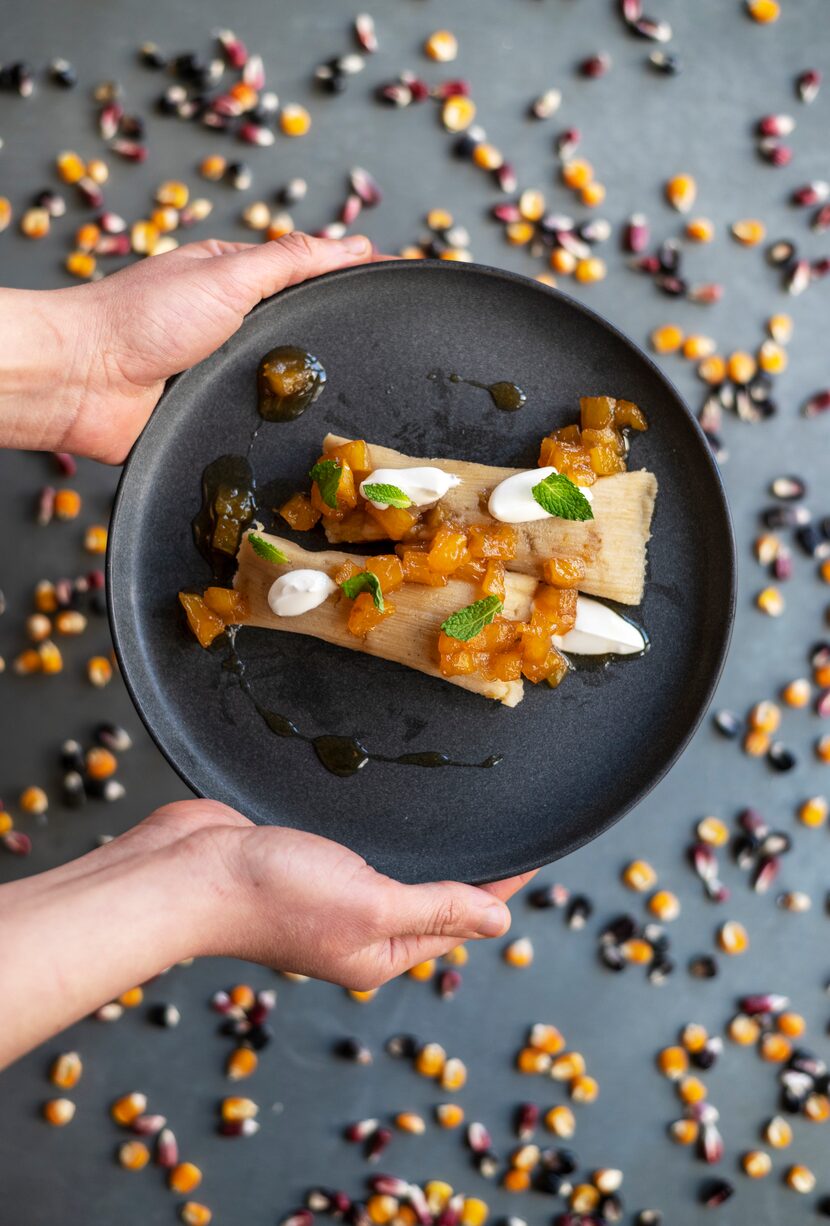
Sweet Pineapple Tamales
These dessert tamales are made from heirloom corn masa flavored with pineapple, filled with pineapple conserva and topped with more pineapple conserva. Dabs of Mexican crema, crème fraîche or sour cream on top make a nice finish, but that’s optional. This recipe calls for soaking more corn husks than you might need because some of them may split and be unusable; you can use those to cut into long strips to tie the tamales with. We also like to use extras to line the bottom of the steamer to prevent sticking. You can use a tamale steamer, Chinese bamboo steamers stacked on top of each other, or any other type of steamer you can make.
Olotillo blanco masa harina may be purchased online from masienda.com.
You can make the tamales several hours or even a day in advance and leave them wrapped. (If serving the next day, store them in a sealed zipper bag, and store the pineapple conserva in a closed jar or sealed container. Let the conserva come to room temperature to serve, and re-steam the tamales until warm.
20 corn husks (allowing for some that may split)
1 cup almond milk (unsweetened)
2 tablespoons unsalted butter
4 tablespoons Pineapple Paste (see recipe below)
2 tablespoons diced pineapple from the conserva (see recipe below)
1 tablespoon syrup from the conserva (see recipe below)
1/8 teaspoon vanilla extract
2 tablespoons virgin (unrefined) coconut oil
2 tablespoons light brown sugar
1 cup otillo blanco masa harina
1 teaspoon baking powder
1/8 teaspoon baking soda
Pinch of salt
12 tablespoons Pineapple Conserva, plus more for serving (recipe follows)
Crema, crème fraîche or sour cream for garnish (optional)
Place the corn husks in a shallow bowl or pan, cover with room temperature water and let soak for 15 minutes or so. Drain.
Place the almond milk, butter, pineapple paste, diced pineapple from the conserva, syrup from the conserva, vanilla, coconut oil and brown sugar in a small saucepan and stir to combine. Place over low heat and cook gently, stirring occasionally, until the ingredients are all melted together, about 5 minutes. Remove from heat and set aside.
In a medium bowl, whisk together the masa harina, baking powder, baking soda and salt. Use a rubber spatula to fold the almond milk-pineapple mixture into the dry ingredients. The dough should be wet but not runny, and not crumbly. You should be able to roll it into small balls without it sticking to your hands. If it’s too sticky, add more masa harina (up to ⅓ cup or more), and massage it in with your hands. If it’s crumbly, add a tablespoon of water and massage it into the dough with your hands. Add water as needed until it is not crumbly.
To assemble the tamales, place a corn husk on your work surface and spread about 50 g (a ball a little smaller than a lime) on to the husk in a layer about ¼ inch thick. Place about 1 tablespoon of conserva in the center of the masa and fold the tamale to enclose the filling, pinching the edges so the filling is surrounded by masa. Fold the husk around the filling and tie with kitchen string or a strip cut from a corn husk. Repeat for the rest of tamales, until you have used all the filling.
Line the bottom of a steamer basket (or baskets, if you’re using the stacking kind) with corn husks and arrange the tamales on the steamer. Boil the water in the steam over high heat, place the steamer baskets in the steamer, cover, reduce the heat to medium and steam for 1 hour.
To serve the tamales, unwrap two tamales, set them on a plate, spoon a couple of tablespoons of conserva over them, and garnish with dabs of crema, crème fraîche or sour cream if desired. Repeat for the rest of the plates.
Makes about 12 tamales.
Pineapple Conserva and Pineapple Paste
1 1/4 pounds ripe pineapple flesh, cut into dice about 1 cm (just under 1/2 inch)
3/4 cups water
1 1/2 cups light brown sugar
1 2-inch cinnamon stick
1 teaspoon lime zest
Place the diced pineapple, water, brown sugar and cinnamon stick in a medium saucepan, stir to combine, and heat to a simmer over medium heat. Once the pineapple starts breaking down, about 10 minutes, reduce the heat to low and cook until the mixture is thick and viscous, about 30 more minutes. Remove from the heat, let cool to room temperature, and stir in the lime zest.
To make the Pineapple Paste, measure 1/2 cup of the conserva and place it in the bowl of a food processor or jar of a blender, and pulse it a few times until it is a loose paste. Do not overprocess; you don’t want it completely smooth.
